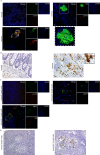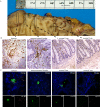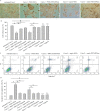Gradient Infiltration of Neutrophil Extracellular Traps in Colon Cancer and Evidence for Their Involvement in Tumour Growth
- PMID: 27136460
- PMCID: PMC4852909
- DOI: 10.1371/journal.pone.0154484
Gradient Infiltration of Neutrophil Extracellular Traps in Colon Cancer and Evidence for Their Involvement in Tumour Growth
Abstract
Background: The role of neutrophils in tumour biology is largely unresolved. Recently, independent studies indicated either neutrophil extracellular traps (NETs) or Tissue Factor (TF) involvement in cancer biology and associated thrombosis. However, their individual or combined role in colonic adenocarcinoma is still unexplored.
Methods: Colectomy tissue specimens and variable number of draining lymph nodes were obtained from ten patients with adenocarcinoma of the colon. NETs deposition and neutrophil presence as well as TF expression were examined by immunostaining. The effect of NETs on cancer cell growth was studied in in vitro co-cultures of Caco-2 cell line and acute myeloid leukemia primary cells. Proliferation and apoptosis/necrosis of cancer cells were analyzed by flow cytometry.
Results: TF-bearing NETs and neutrophil localization were prominent in tumour sections and the respective metastatic lymph nodes. Interestingly, neutrophil infiltration and NETs concentration were gradually reduced from the tumour mass to the distal margin. The in vitro-generated NETs impeded growth of cancer cell cultures by inducing apoptosis and/or inhibiting proliferation.
Conclusions: These data support further the role of neutrophils and NETs in cancer biology. We also suggest their involvement on cancer cell growth.
Conflict of interest statement
Figures





References
Publication types
MeSH terms
LinkOut - more resources
Full Text Sources
Other Literature Sources
Medical
Miscellaneous

